I’m growing weary of featuring wildlife encounters with barbed wire on my blog and I’m sure some of my readers are too (that’s one of the reasons I’ve put this post off for over a month). But dammit, I just can’t stick my head in the sand and pretend this kind of thing doesn’t happen. I’ve documented a dead Burrowing Owl strung up in the stuff, rescued a Barn Owl hanging from it that was eventually released back to the wild and Mia and I recently rescued a Short-eared Owl whose wing was so badly mangled by the wire that its best hope is to be kept in captivity and used as an education bird for the rest of its life. I’ve even photographed a dead bat hanging from barbed wire. And a month ago it happened again – this time it was a young pronghorn fawn hung up in barbed wire. Barbed wire has been called “devil-rope” for over a century now and for good reason.
For the more sensitive types please know that there are no gory photos here, though a couple of them may tug at your heartstrings. All images were taken in the Centennial Valley, most of them last month.
But first a little background.
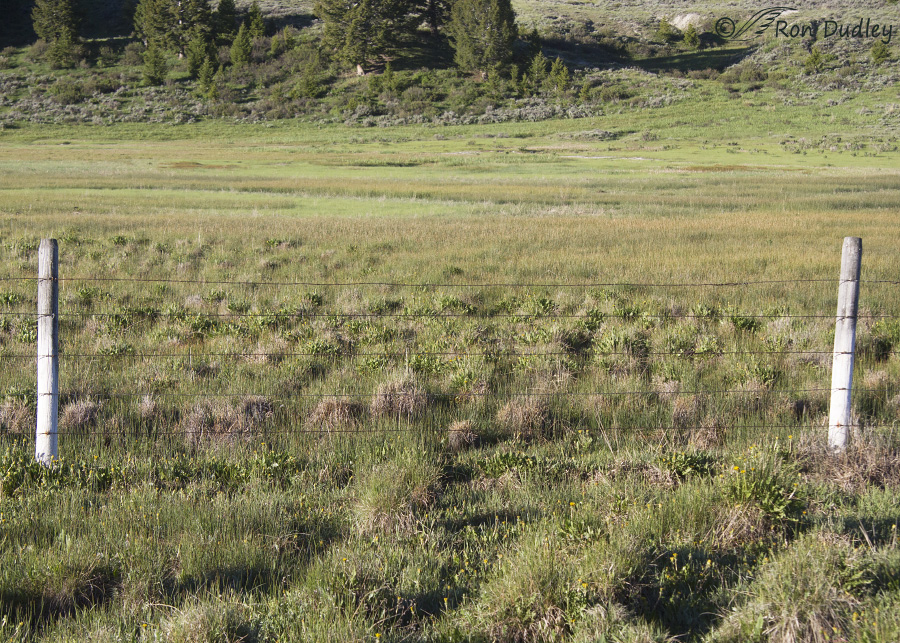
Montana’s spectacularly beautiful Centennial valley is huge and most of it is privately owned by cattle ranchers who must contain their cattle with fences. There are hundreds of miles of fences in the valley and nearly all of them are made of barbed wire. This five-stranded barbed wire fence is typical but some have as few as three strands and others have up to six. Different types of wire are occasionally used but barbed wire is the norm.
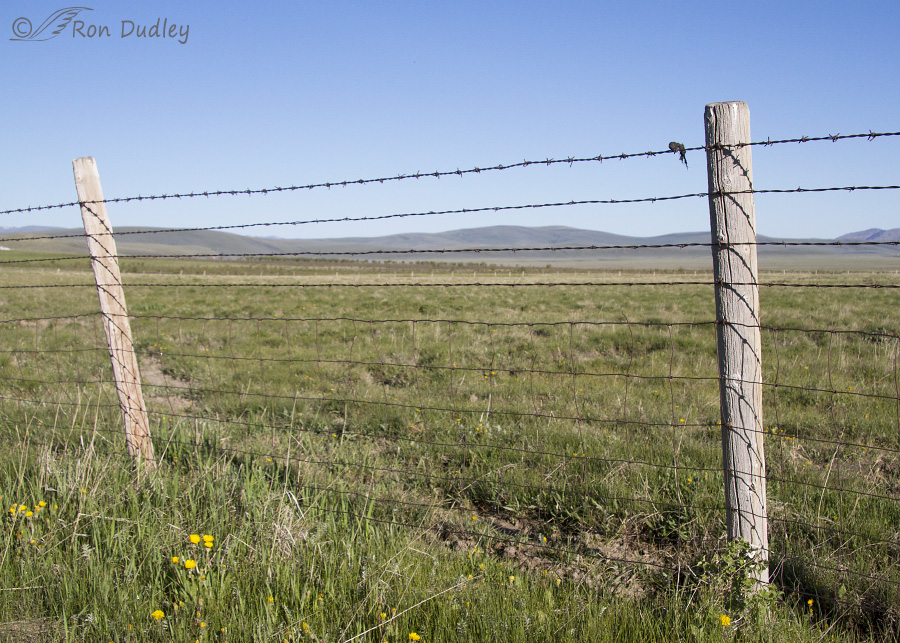
Some of them have so many strands of several wire types that nothing bigger than a jackrabbit could get through (if you look closely you can see another fence in the background). But most fences in the valley are made only of barbed wire.
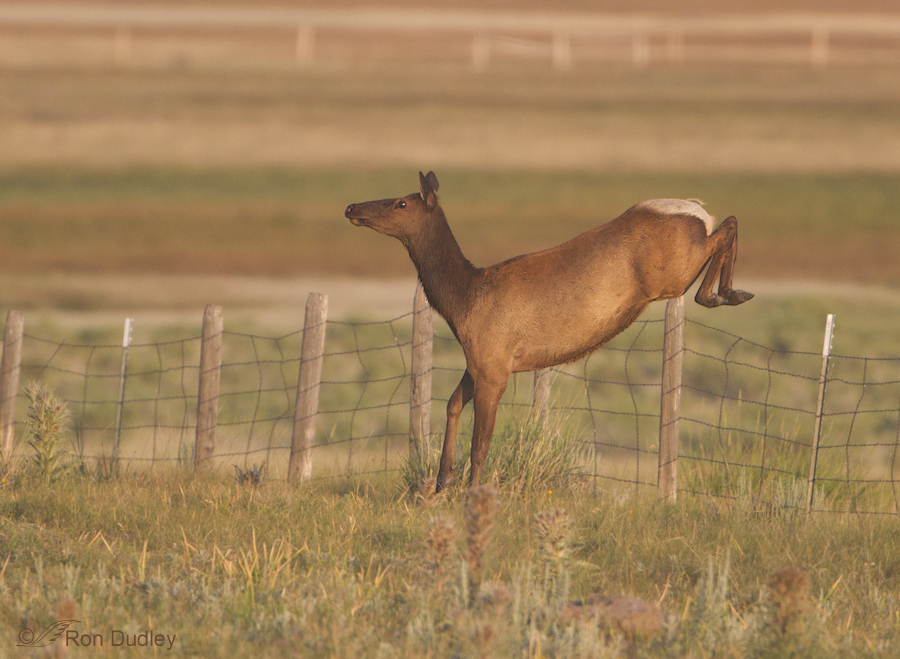
Most larger adult mammals like elk and deer generally have no difficulty jumping the wire fences. The biggest danger to them is getting their hind legs caught between two closely-strung wire strands at the top of the fence as they’re going over and that does happen occasionally but typically they negotiate the fences successfully.
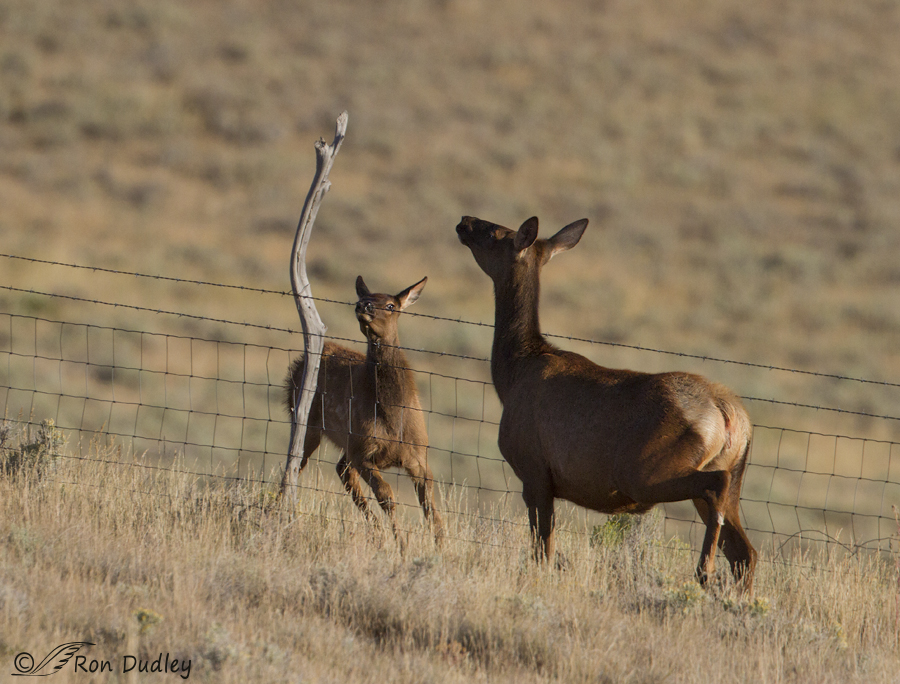
Young deer and elk are another story. This cow elk and her calf (on a hillside, thus the slant of the image) became separated by the fence and both panicked until they found a weak spot the calf could pass through.
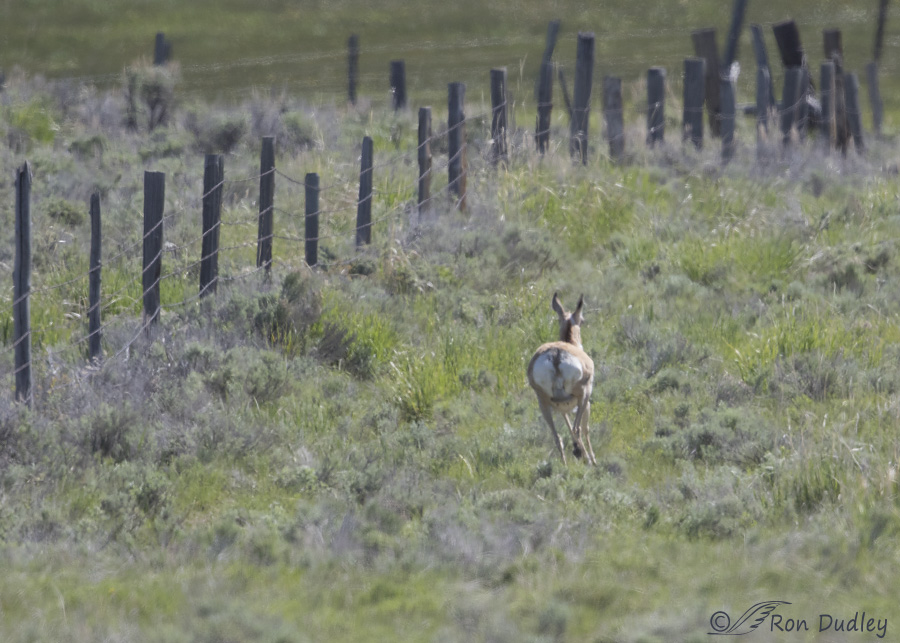
But in the American West the biggest danger of barbed wire for large, wild mammals is to the pronghorn. Interestingly this species, the second-fastest land animal in the world (second only to the cheetah so it must have very powerful legs), typically doesn’t jump fences. It either can’t or it won’t. Usually. In six decades of sporadically watching pronghorn I’ve only seen a pronghorn jump a fence once. Pronghorn much prefer to find a weak spot in the fence and scoot under it and that’s what they nearly always do.
This one was caught between two fences lining the road when I approached in my pickup. It panicked as it desperately looked for a spot in the fence it could get through. I stopped and watched and it eventually made it through the fence. But if I’d have proceeded at my original speed it likely would have taken a chance on a less open spot in the fence and it could have become entangled in the barbed wire.
It isn’t an unusual occurrence to find old pronghorn hides hanging from barbed wire. I’ve seen it many times myself, especially in Montana.
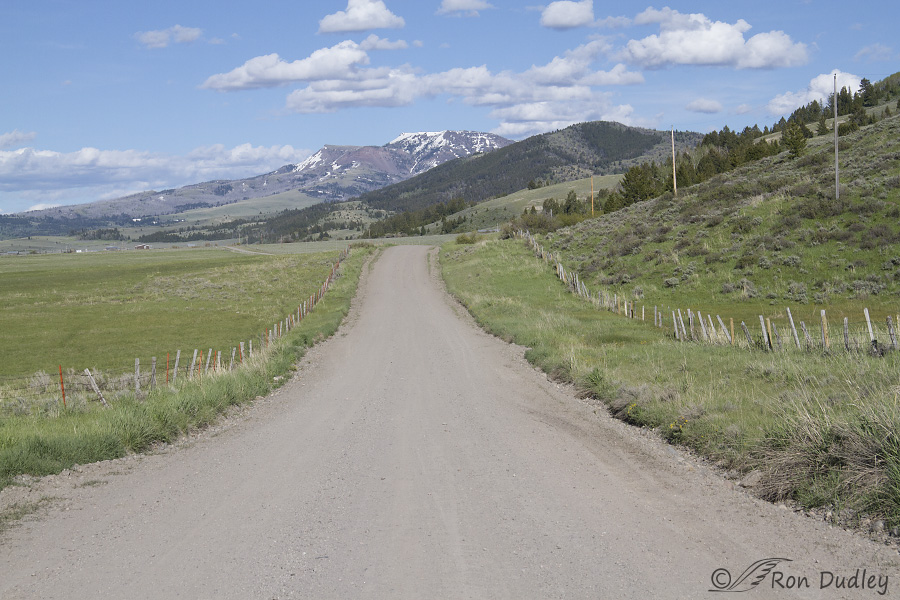
This is the South Road – the 30 mile long gravel road running east/west through the Centennial Valley. As you can see it’s a gauntlet of barbed wire for any relatively large mammal caught between the fences on either side of the road when a vehicle comes by. Those vehicles include intimidating, noisy and huge logging and cattle trucks but even a single small car can cause panic in a pronghorn caught between the fences.
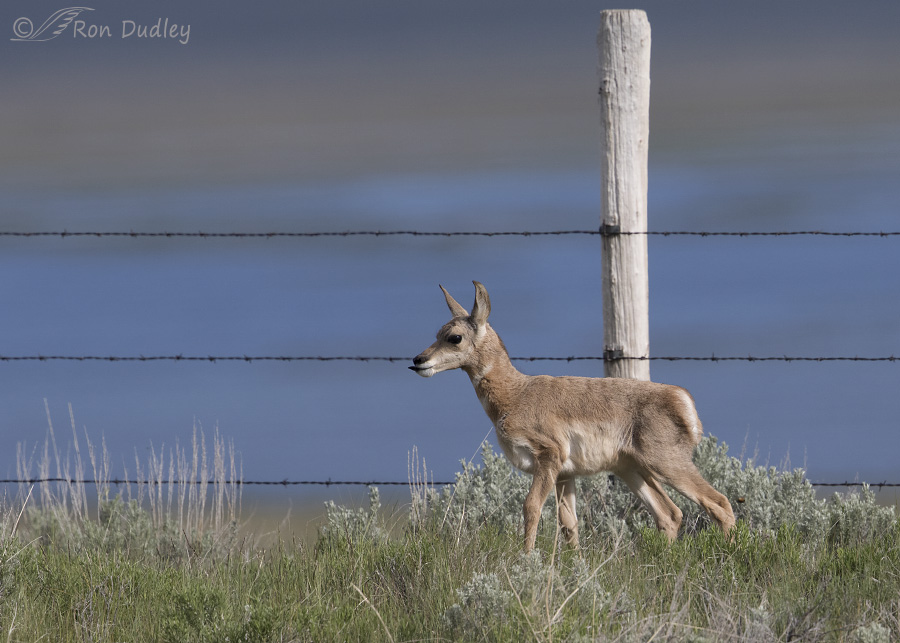
When there’s no threat the pronghorn seem to accept the fences as part of their environment, as this young fawn was doing as it frolicked near the fence line with its mother nearby. But when a vehicle comes by, acceptance can turn to panic in an instant.
And last month I was inadvertently the cause of just such an incident.
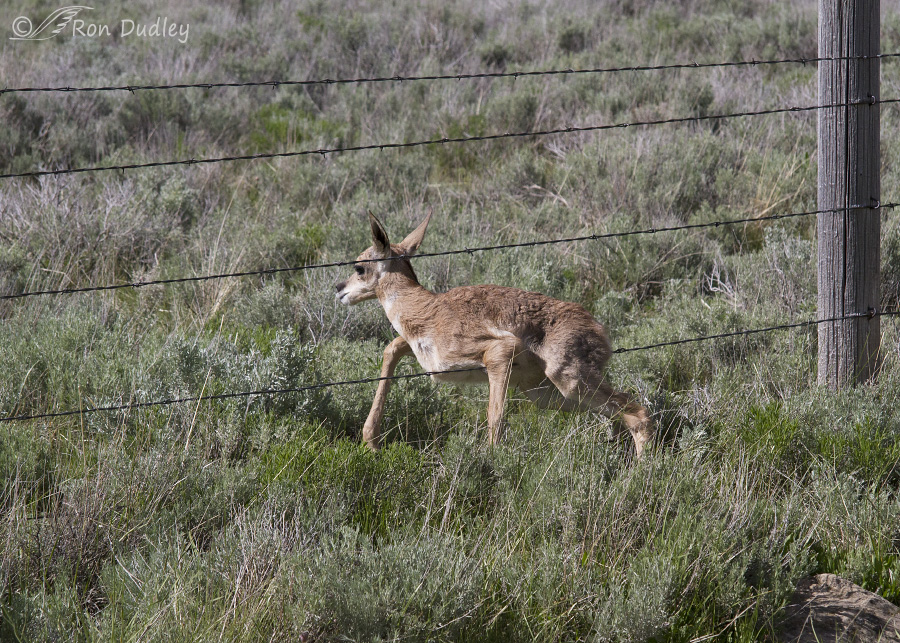
Just over a month ago I was driving the South Road looking for birds when I spotted a doe pronghorn with very young twins in front of me and they were trapped between the fences on either side of the road. As soon as I saw them I slowed to a crawl to allow them to find a spot in one of the fences where they could cross to safety. Eventually the adult and one of the twins made it through the fence but the other youngster wasn’t so lucky and was snagged by the barbs.
I got out of my pickup and approached the young pronghorn slowly and as I did the other two moved off to a safe distance. The fawn was firmly snagged by a single barb under its left front “armpit” and though it struggled to free itself it just couldn’t.
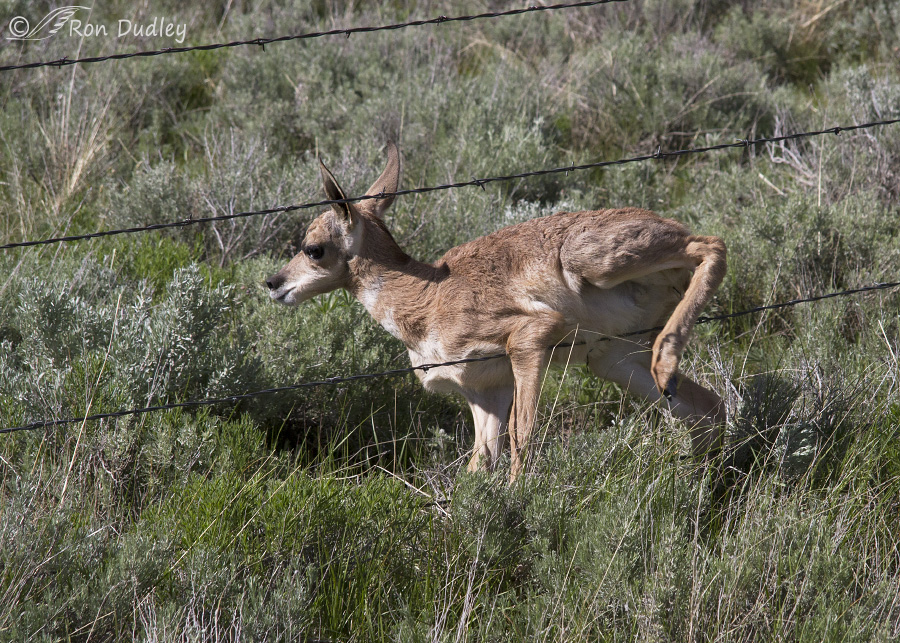
A closer look shows that the rear leg wasn’t caught in the wire, only the front one.
As I reached down to free the fawn I was struck by how tough and wiry “he” felt (I’m really not sure of the sex). I guess I expected him to feel soft like some other mammal babies but he was far from it. He was bleating like a lamb in fear and the little rascal kicked my right arm hard with his left rear leg. Good for him! He definitely had his survival instincts intact.
There was very little damage in that short time – just a little blood under his leg when I extracted him from the wire. As soon as I did he was off like a shot and joined his mother and sibling.
I wish something could be done about these fences. I realize that ranchers have to contain their cattle but it seems to me that with a little ingenuity a fence design that’s safer for wildlife could be developed. I know from conversations I’ve had with staff at nearby Red-rock Lakes National Wildlife Refuge that efforts are being made to influence local ranchers in that direction.
Ron
PS – Another event involving a fawn pronghorn (but no barbed wire) on this trip left several of us heartbroken. At dawn I was approaching the South Road from the road to the lower lake campground when a pickup came along from the east. I waited for him to go by before I pulled onto the road because I knew I would be going very slowly as I looked for birds but I had to wait a while because he was driving very slowly himself (perhaps 20 mph on the gravel road).
But within seconds after I pulled onto the road I noticed that the pickup had stopped in the middle of the road in front of me. Its driver got out, looked behind his vehicle and then walked back to us and he was almost in tears. He was a biologist for the refuge and he had struck a newborn pronghorn fawn in the middle of the road and killed it – the youngster had raised its head as the pickup passed over it. Fawns this young instinctively hunker down to hide and the biologist simply didn’t notice it. They’re very small at this age – without their long, gangly legs they’re not much larger than a jackrabbit.
Needless to say that event colored the rest of our morning.


Thank you so much Ron for saving the little pronghorn. It is so sad that so many animals have to suffer because of the awful barbed wire. I don’t know if cattle can jump, but couldn’t they make the fences narrower and make the opening at the bottom wider so other animals can pass without getting caught on the wire. It is such a horrible way to die. And the pain must be awful too. Just a thought.
Thank you, Ron for a very sobering introduction (for me) into the matter of fencing and wildlife. Your photo essay is very compelling. Have you considered sending it on to Nature Conservancy? I could almost see the tears of the biologist and was grateful that you were able to free the fawn. We simply must make room in our world for other living beings.
Elizabeth
Hi Ron,
I found your blog of interest. The use of barbed wire, often on the top strand only, has been widespread in Australia. However, there is move towards replacing it with plain and another towards using electric fencing (usually solar-panel powered) as the effectiveness of barbed wire is less obvious than initially thought. Down here we frequently see fruit bats (flying foxes) and micro bat species caught on barbed wire, and kangaroos of various species are commonly caught as they try to jump the fence and their feet go under the top wire, leaving them trapped and hanging upside down. The latter is particularly obvious when a new/additional wire – often an electric plain – is fitted above previously existing wire – the animals don’t expect it and misjudge the jump height required. An interesting aside is that our feral camel population has no regard for fences of any type and frequently go straight through them.
I very much appreciate your considered and thoughtful contributions and the superb images – keep up the good work.
An excellent comment, Gary! Informative and interesting.
I did a little digging on your feral camels. Wikipedia said that by 2008 Central Australia had a bout one million of them and that number was expected to double every 8 to 10 years (control efforts have since reduced them significantly). I can’t even imagine that many of those huge mammals running loose and roughshod over the environment.
Tears.
And yes, there must be a better alternative. The fact that people are starting to say and think that is a start. Which I really hope can be continued.
EC, based on the link provided by Louise below I think there may be more than one “better alternative”…
I just had this conversation with a friend. She asked me do the barbs really make a difference vs just a wire fence to stop the horses and cattle from wandering out of the property? What is you experience on your family farm?
April, we had very little fence on the farm back then and we didn’t have any cows. I had a horse but we just staked her out along the creek in the summer and during winter she was kept elsewhere. What little fence there was on the farm was barbed so I have no experience with the effectiveness of barbless wire controlling livestock.
My uncle had a fenced pasture for his few cows and horses and that wire was barbed, as were most of the fences in the county.
There is a publication I have, produced by Montana Fish & Game, on ‘wildlife friendly fences.’ I’ll look for it. I really liked it. In the meantime, here are some references – all, interestingly, from Montana.
http://fwp.mt.gov/mtoutdoors/HTML/articles/2009/fencing.htm
http://fwpiis.mt.gov/content/getItem.aspx?id=34461 – this is the one I have, and really like.
https://www.mdt.mt.gov/publications/docs/brochures/friendlyfences.pdf
Someone should distribute these in the Centennial Valley. sigh.
Wow, that second link has it all, Louise, including some fascinating and tragic research statistics. That bear that climbed a power pole to jump over a fence says a lot about the efforts wildlife make and the risks they take to get over them.
That second link is simply excellent.
I’m not really sure about the rationale behind the barbs. Doesn’t seem to be much of a deterrent for leaning on the fence. I know in Namibia, where there are lots of cattle and wildlife (and antelope species that don’t like to jump fences) they don’t use barbed wire. Their fences are usually 4 or 5 strand, barbless wire. The wildlife goes through or over without much of a problem and their cattle are contained just fine. They tend to think our barbed wire is unnecessary. It would be interesting to find out how many other countries use barbed vs barbless wire and the rationale behind it.
Some very interesting observations, Larry. Makes you wonder, doesn’t it?
Definitely a heart-rending story, but I’m glad you were able to free the baby caught in the fence. The one time we’ve seen Aoudads (Barbary Sheep) out at Hueco Tanks, there were two adults and a juvenile. The adults had no trouble jumping the fence. The little one wanted to, but couldn’t seem to. When they all crossed the road back to the park side, the little one found a way under the fence. (When we saw them we stopped our car and just watched until they were safely back beyond the fence.) It just occurred to me that I’ve never checked to see what the park fences are made of.
“It just occurred to me that I’ve never checked to see what the park fences are made of”
That might be interesting to know, Susan…
Ron–did you take these images down ? All the rectangles I received were either all black or all white .
No, I didn’t, Kris. This post is still loading correctly for me. Try rebooting your computer – memory issues can sometimes cause that to happen.
Ron, I share your anger. And like you, I firmly believe there is a fix for these issues, but it takes the desire and commitment to LOOK for a better way (with wildlife safety as a design parameter) and then ACT instead of just repeating the tired old responses that boil down to “We’ve got to do it this way because this is the way we’ve always done it.” I call BS on that way of thinking. At some point, we have to realize that we actually SHARE this spinning rock with other species, and if we don’t, not only are our lives diminished, but our very survival is at stake.
I can only imagine the sorrow the biologist felt at killing the newborn fawn. So very sad…
Thank you so much for rescuing that little one! But then, that’s who you (and Mia) are. What a blessing you guys are!
And as usual, what a stunningly gorgeous set of photos! I so miss those vistas!
“I can only imagine the sorrow the biologist felt at killing the newborn fawn”
He was extremely upset, Laura. And he certainly didn’t do anything wrong – if it hadn’t happened to him it might have been me since I was right behind him. There are so many road-killed jackrabbits on this road that eventually one hardly notices something this size lying in the road.
I get that Ron. And no matter how diligent we are, sometimes disasters happen anyway.
Great job!
Many thanks for the images and the information.
I can’t understand why people, especially those in rural areas, have a hard time realizing that we share this planet with wildlife. We are not king of all, even though we act it out. Our disregard of our behavior toward wildlife in general will eventually come back to bite us.
Glad you rescued this fawn!
As you know it’s already “biting us”, Dick, but lots of folks are just too dense to accept that fact.
Another great series, and a great act of kindness by a good Samaritan,
but from you I would have expected nothing less. What is the answer,
or the alternative to barbed wire? I wish I knew. What ever it might be,
it will be expensive, time consuming to implement, and not without much
controversy.
“and not without much controversy”
Boy, that’s for sure, Roger.
Hello Ron, As we are active in the “Wildlife friendly” fence community with the Sage Grouse Initiative ( http://WWW.FENCE-FLAG.COM ) that has promoted VISIBILITY to mitigate fence strikes, especially Barbed Wire, we have noted thru the Federal Business Opportunities (FBO.GOV) the numerous references of new fence designs mandated for bid opportunities that Barbless Wire be installed on the bottom horizontal line to address the hazards of those that insist going under a fence barrier, such as Pronghorn do on many occasions. We have long advocated that Barbless Wire should be also used on the top strand as well for those that prefer to jump and those that impact in low flight, especially in darkness. For our personal experience; on a business trip as Exhibitor this past March 9-11 2016 to Gunnison, Colorado, for the Sage Grouse Summit; Dolores and I did experience a pair of adult Pronghorn on the road, near the Florissant Fossil Beds National Monument just West of Colorado Springs as we rounded a bend, and it was quite obvious by their agitation they were perplexed by the Barbed Wire barrier, BUT, they both literally leaped and cleared the fence–without a running start! Your postings are a bright spot in our day as we look forward to them each morning! Thanks, Don
Donald, I’ve heard discussions about the barbless wire as the top and bottoms strands before. Sure wish it was more common than it is but hopefully it’s a trend, especially in wildlife-rich areas.
Interesting that you’ve seen two pronghorn jumping a fence. I’ve seen some online references that claim that some individual pronghorn “learn” to do it and after they do they usually jump rather than scoot under the wire.
Don I so appreciate your work with the Sage Grouse Initiative. Thank you! I think if we keep pushing, educating and pushing some more, this whole “Wildlife Friendly” concept can happen, not only with fences, but with other hazards as well. Yes, the money aspect keeps coming up, but if these actions are taken over a period of time, the cost is mitigated, and as with the work of installing fence flags, each action taken makes the world a little safer for wildlife.
A few of the fences in the Centennial Valley have been flagged, especially in areas where Sage Grouse are fairly common. It seems to me that those flags could help with other birds too, including owls.
The flags and barbless wire top and bottom are interesting concepts. Only trouble with barbless on the top is those cows/bulls that like to “lean” on the fence. Has to be a solution………..
It’s sad. Here too. In a two mile stretch of a dirt backroad. 2 dead antelopes. Struck by 4 wheel trucks or jeeps. And this is just one road in desert. Struck by people obviously driving too fast.
Yup, excessive speed on these remote roads is definitely an issue for wildlife, Marina.
Even Whitetail fawns get hung up and perish occasionally. 🙁 At least you could save the antelope! Husband Joe refers to Antelope as “goats” for their stringy toughness. 🙂 Finding some wire, without the barbs, that will contain cattle is the challenge. Perhaps “someday” someone will figure it out. The, of course, the time/money to replace it all becomes an issue………. Sigh……..
“the time/money to replace it all becomes an issue”
Exactly, Judy – the solution wouldn’t be cheap. I’ve researched that a little. The average price for a quarter-mile spool of barbed wire seems to be about $80. At that price a mile of five-stranded barbed wire fence would cost about $1600. Ranchers typically have many miles of fence and that cost doesn’t include the price of the posts and the labor involved with installing the fence.
Barbed wire is horrid for wildlife. I certainly am not smart enough to know what a better alternative would be.
Charlotte
Me either, Charlotte. But there must be one. I hope…